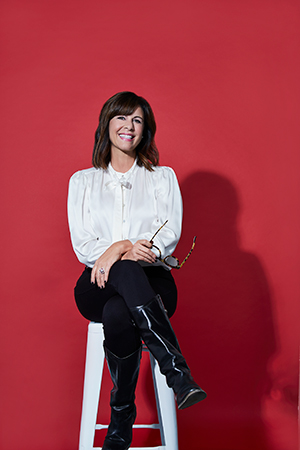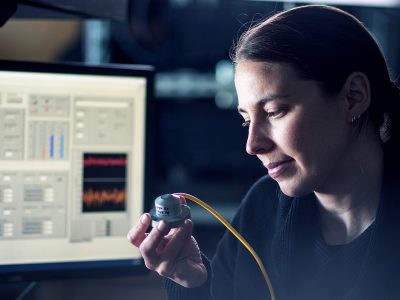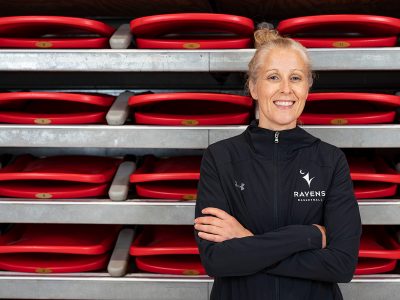By Rick Boychuk
Photos by Rémi Thériault
How much knowledge can students absorb in an online class with all the distractions of home life bubbling in the background?
It’s difficult enough in a university setting to compete for their attention with texts, games and news streaming into their devices. Studying from home presents an even greater variety of interruptions (pets, phone calls, pesky siblings) and temptations (pie in the fridge, poker websites, pals next door).
University students are expected to take responsibility for their schedules and class work, but the pandemic is not life as normal. So the challenge for Carleton’s professors, who had to swiftly develop online versions of their classes over the past few months, is figuring out how to engage students in course material while we are all coping with isolation, economic uncertainty and the fear of contracting a highly transmissible disease.

Prof. Melanie Adrian
Religion and human rights scholar Melanie Adrian decided to focus her efforts not on what interactive software to use but on how to create ah-ha moments online.
“How do we expand horizons on Zoom?” asks Adrian, who was appointed one of Carleton’s inaugural Chairs in Teaching Innovation in late 2019.
“I believe that new ideas are absorbed through reading, watching and learning, but those ideas need conversation to further open horizons. That’s the challenge with being online.”
Adrian, who has never been confined by conventions in the classroom, decided to address this issue through an experiment. In September, she relaunched two versions of her fourth-year Law and Legal Studies class online. She is surveying students in each of the classes — which she has provocatively titled “Is Religious Freedom a Human Right?”— three times during the semester to assess which method works better.
Adrian spent the spring and summer rebuilding the course, mapping out her research protocol and, with her partner, caring for their two children (“I am a counsellor and cheerleader and chef and cleaner.”) She was, she admitted, “barely keeping my head above water.” She survived by being organized and disciplined about her time, parsimoniously parcelling it out among the many tasks at hand.
Like many other professors, Adrian had to put research projects on hold to focus on redesigning her courses. A process that would normally take one or two years had to be condensed into three months. The backdrop to this rapid transformation is the bumpy merger between our new digital reality and the day-today tangible world.
With widespread access to broadband internet and a variety of interactive platforms available, content is easier than ever to deliver. These technologies — which have had a disruptive impact on post-secondary institutions because they now face global competition — can help but aren’t a cure for our pandemic-induced psychological ailments.
Fear of infection, the absence of social contact with family and friends, and children out of school and daycare are taking a toll on our individual and collective mental health. Women, in particular, are feeling the impact. Recent studies show that women’s research output has decreased by about a quarter over the last eight months as women struggle to balance research with child and family care.
While Adrian recognizes her own privilege as faculty member, she’s attuned to the fact that specific populations are experiencing the pandemic in different ways.
“We know that marginalized people and poor communities are bearing the brunt and burden of this,” she says.
“What are the values we want to guide us through this? My average class will have a fair number of students who have official accommodations. Another 5 to 10 per cent will have different kinds of needs: learning, social, psychological. And students are going to have all sorts of emotions about being online. Not being social enough. Not going out. There’s going to be another layer of care added on to what we are doing.”
These disparities and needs, coupled with distancing and isolation, may sap some of the joy and intellectual growth from the university experience. They may also exacerbate the high rate at which students quit online courses.
Online dropout rates vary across countries and schools but are generally acknowledged to be significantly higher overall than for in-class courses. How, then, can one encourage students who are separated from each other to come together in a community of learning?

Lifelong Teaching
Adrian’s interest in innovative approaches to teaching was cultivated in childhood. She was in Grade 2 when her family immigrated to Canada. Her father was a professor of optometry at the University of Waterloo and her mother was a teacher who became known in the community for her social activism.
The Adrian household was always bustling with international students. Nearly three dozen lived with her family for at least half a year, she recalls, and many more stayed for a couple of weeks.
 In high school, she was selected for a Rotary exchange scholarship and spent a year living in Mexico. Then, after completing an undergraduate degree in religion and peace and conflict studies at Waterloo, she took a job teaching English in a fishing village in Japan.
In high school, she was selected for a Rotary exchange scholarship and spent a year living in Mexico. Then, after completing an undergraduate degree in religion and peace and conflict studies at Waterloo, she took a job teaching English in a fishing village in Japan.
“Teaching is dramatically different in the Japanese classroom,” says Adrian.
“Students are expected to memorize, especially in language learning. I would ask questions and there would only ever be one answer. Because that’s what they memorized. ‘Hello, how are you? I am fine, teacher.’ So I changed things around dramatically. I really wanted to give all students an opportunity to use English inside and outside of the classroom.”
After Japan, Adrian completed a master’s degree on the Theory and Practice of Human Rights at the University of Essex, then a PhD in Social Anthropology and the Study of Religion at Harvard University. During her doctoral and post-doctoral work, also at Harvard, she began teaching undergraduates and trying different approaches.
One of her classes was physiology and sexuality. The students called it Sex 101. While teaching this course, Adrian learned to always have a plan, how to deal with awkward moments and how to bring students back to class if they felt put off or overwhelmed.
That experience set Adrian up to teach in Harvard’s freshman seminar program, in which professors teach a small group of first-year students on a vast array of topics, everything from Bob Dylan to black holes. “It’s meant to give students an intensive, immersive experience and to get them to know a professor well,” she says, “so you can try something totally new.”

Adrian taught two of these tutorials and considers it her first opportunity to really learn how to teach. She developed a reputation for engaging students in “weird and surprising ways,” as one wrote on an evaluation form, using poetry, music and art to illustrate her points and stimulate discussion. “Does this resonate with what we are doing?” she would ask. Generally speaking, at least a few of the students would start talking and others would join in. But there were flops.
One course she taught at Harvard had 80 students in class and 100 online. “We just recorded the lecture and made it available,” says Adrian. “There were some group interactions, but we didn’t have the platforms or technology that we have today. It was fascinating to see what kind of students took the course and how they interacted with us. Some were taking it out of interest — it was a world poverty and human rights course — and had very busy lives. They didn’t want to interact; they just wanted the information they needed to be able to complete the assignments.
“There was a small group that learned really well online. But the majority needed to digest the material in other ways and didn’t feel they were part of a learning community.”

A String of Teaching Distinctions
Adrian arrived at Carleton 10 years ago having been awarded three distinctions in teaching at Harvard. At Carleton, she has earned a clutch of teaching awards from the Faculty of Public Affairs and the university. Her students, colleagues and university administrators have all praised her skillful planning and creative initiatives.
Professor Ummni Khan calls her a “pedagogical pioneer” who employs groundbreaking techniques to make the course material relevant and meaningful to the lives of her students. Patrick Lyons, the director of Teaching and Learning Services, says Adrian strives to ensure that her students “not only learn the theoretical aspects of the material on a cognitive level, but experience personal growth from the process.” And former students rave about her passion, warmth and encouragement.
In 2012, Adrian attended a talk by Harvard physics professor Eric Mazur at Carleton’s annual teaching conference. Mazur, who believes that professors need to shift their “focus from teaching to helping students learn,” has written widely about the shortcomings of the traditional lecture format.
He is the author of Peer Instruction: A User’s Manual, a pedagogical approach that encourages students to discuss and debate their course material with each other. Doing so helps them to not just passively fill their notebooks but to absorb the material on a deeper level.
Mazur’s talk helped Adrian think about how better to engage her students and, at the same time, deal with larger classes. “The number of students we have is increasing,” she says. “We have to ask ourselves how we are going to be able to continue to provide quality and meaningful educational experiences within that reality. I was facing courses where I had 65 students at the third-year level. There is no way I can ask them to write 15- or 20-page papers to help me understand what they know and how they know it.”

Inspired by Mazur, Adrian tried a new approach to testing students in a third-year required course. “I had the students write three multiple choice questions and the rationale for the questions. Then they took the 90-question multiple choice exam individually. The exam was held in the same innovative teaching space where we had held the class. There are studies that show if you take an exam in the place where you learned the material, it increases your success. There is more memory, more recognition of the context.”
After they took the exam on their own, Adrian split the class into randomized groups of four to five students. They took the exam again as a team and had to agree on which answer was the correct one. “They were discussing and persuading each other and deliberating,” she says. “It was quite lively. They finished the exam knowing what all the answers were and they had reviewed all of the course material at least three times. They left having had an engaging, fluid and interesting conversation about the material that they had been exposed to throughout the semester. Our studies show that this is quite successful.”
For her online course this year, Adrian is attempting something different. In one version of the class, students are divided in half; she meets with each section in a virtual tutorial once a week. In addition, students are asked to blog in response to question prompts.
“Each student will have to make three interventions weekly,” she says.
“They will write a blog post and respond to the writing of two classmates. My hope is that this will be a conversation.”
In the other version of the course, she has divided the class into learning pods of three students. These groups each create their own blog rather than participate in a class blog. Final marks will be based on blog posts, participation in the tutorials and a final paper or podcast. Adrian plans to survey the students in both classes to assess whether those in the learning pods feel they are learning more or less because they are interacting in a small group with people they are getting to know.
“Learning is about risk,” she says. “Others won’t see the learning pods’ blogs. I’ve done that because I’d like trust to build up. I’d like them to become familiar with each other. Will students in small groups take more risks? Will they feel that they are part of a learning community? That’s the study.”
What excites Adrian as a teacher is seeing what she calls that “moment of understanding and change when a student comes into an understanding of a new framework. All of a sudden, their eyes and body shift. That widening of the horizon.”
Mazur argues that learning is, first and foremost, a social experience. It may be more difficult for Adrian to see that eye widening online, but her experiments and research are attempts to ensure that her classes remain a social experience, that her students feel less isolated from one another, that they are absorbing and thinking about the material, and that they are at least slightly less distracted by that pie in the fridge.

Monday, November 23, 2020 in Features - Fall 2020
Share: Twitter, Facebook



